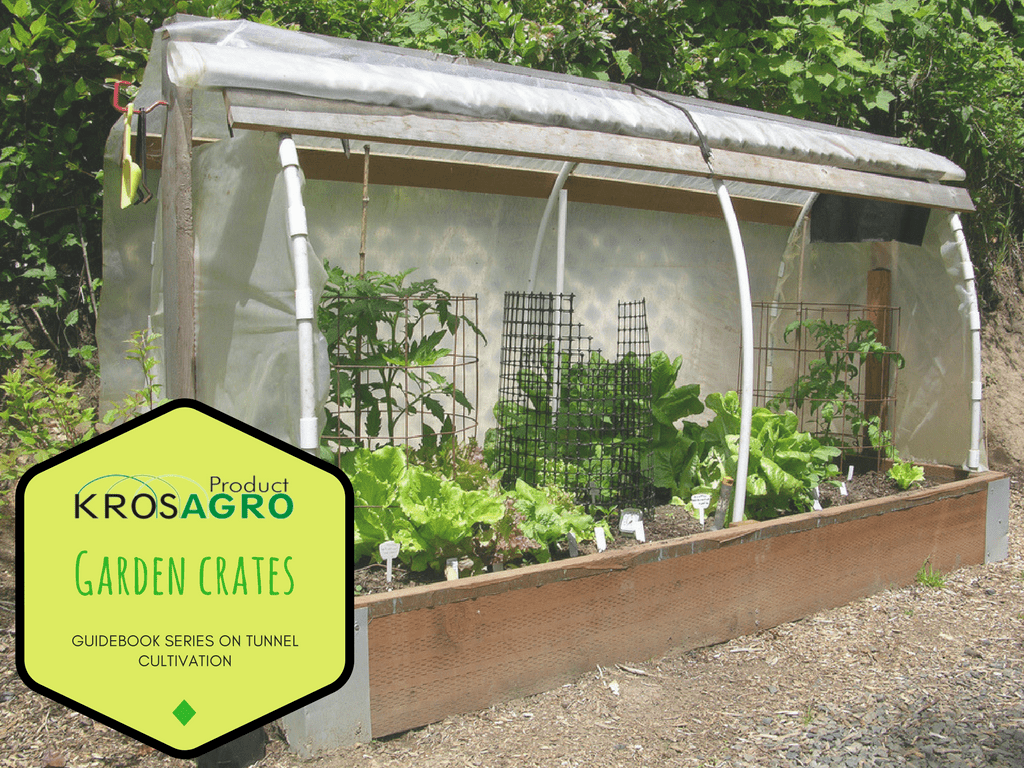Garden crates are raised gardening beds, allowing easier plant cultivation under cover. Thanks to such constructions, we can diversify crops in a polytunnel with different plant species and varieties. Such stands enable the creation of particular growing conditions for vegetables and fruits, as the crate can be filled using soil with a different PH, structure and content. When using different soil types mixed in a traditional way. Some plants would get weak, while others would thrive under comfortable conditions. In the case of garden crates, the ground is held in separate containers and does not get mixed. So we can cultivate several non-compatible plants under cover.
When fertilization is required, only the soil in the box is treated rather than the whole site. That way, we avoid spending too much, and in the event of a mistake, losses are limited. For those who have problems bending down, as well as people with disabilities. Raised beds offer a solution to cultivate plants in a greenhouse. Such separated “beds” improve the management of the polytunnel. Booklets and notes identifying species in any given stand will help you remember which care duties were done or remain to be done.
In this Krosagro guide, we will tell you more about garden crates in polytunnels and what they are made of.
Contents
Garden crate construction:
Polytunnel and cultivation technology
Polytunnels have a limited space, but there are many ways to expand them. With the use of garden tables, vertical cultivation, coordinate cultivation or hydroponics for example. Some of those solutions are expensive. But more and more often, hobby gardening benefit from cheap technologies that are used on a daily basis in professional plant production. The more optimal the cultivation, the better the harvest, leading to considerable savings. A modern vegetable garden constitute a healthy way of life, free from pesticides.
Crates are one of the cheap ways to optimize crops. We can buy a ready-made structure, but it is also easy to make it yourself. Internet is a source of video tutorials on how to prepare a garden crate.
Size:
Dimensions will be dictated by how much space we can devote to garden crates. Obviously, the larger the area, the more space for planting. By the way, remember what spacing is required between plants. In order for this process to run smoothly, it is worth drawing a development plan. Thanks to this, we will use every inch of the greenhouse.
Shape:
It is very important during care treatments to have easy access to every bit of the crop. That is why, at the very beginning of tunnel planning, convenience should be included in the project. Oval shapes compared to sharp ones are safer for the foil, as strong wind could damage the plastic cover against the corners of the crate. To avoid this, keep a gap between walls and cover. We can also choose oval or ovoid shape, which are sometimes less practical, for their interesting appearance.
Depth:
This feature will depend on the type of plants we intend to grow. Many species have a particular root system : usually shallow or deep. It is essential that soil structure is adapted to the type of plant to allow proper root system development. 15 cm is the minimum depth for growing vegetables, but in the case of fruit shrubs it should be doubled, and sometimes even triple. If it is not a one-year cycle production , take into account how much the plant will grow the following seasons. By creating favorable conditions, we guarantee a bigger yield. The longer the plant stays in one place, then the harder it is to move it to a new location without damage.
Material:
We have a wide choice concerning materials. A lot of them are made of impregnated wood, hay bales and even plastic. All depends on the budget allocated for the construction of your gardening crate. Wood, depending on the species, could represent a difference in price, long plastic strips , though durable, should be neutral for the soil and contain no additional dyes. If you build the crate yourself, think about board connection and how to secure them.
Biotope in the gardening crate
Soil fertility is one of the most important factors affecting plant development. Plant families have various preferences regarding content, type, structure and concentration of elements in soil. The fertilizer should also be selected according to the type of soil. Having at our disposal several growing sites, we can generate contrasting conditions in each of them . The first crate can have a basic soil, the next an acid one, with a neutral in the third. In order not to interfere with the ground under the crate, apply agro textile at the bottom of the structure.
